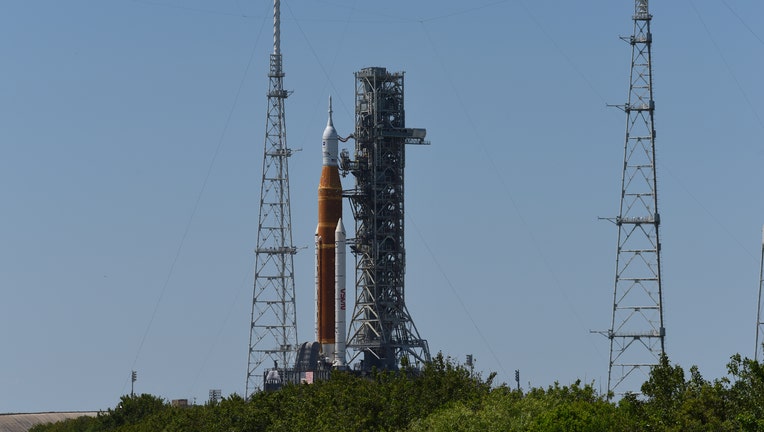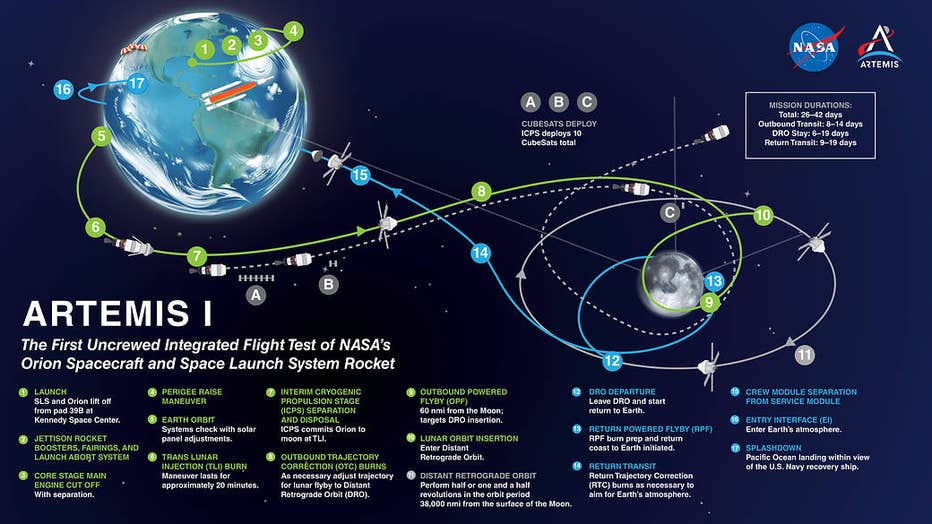What is NASA's Artemis 1 mission going to do?

CAPE CANAVERAL, FL - APRIL 8: The Artemis 1 Moon rocket with the Orion capsule sits on Launch Pad 39B at the Kennedy Space Center April 8, 2022 in Cape Canaveral, Florida. NASA had scrubbed two efforts earlier this week due to pressurization and valv
NASA is in the final stretch before it launches the first rocket in 50 years designed to carry humans back to the moon. Liftoff is scheduled for late August from Kennedy Space Center in Florida.
The Artemis 1 mission is the first test flight of NASA’s Space Launch System rocket and the Orion spacecraft.
Artemis refers to the name of NASA’s campaign to return humans to the moon's surface by 2025 as a jumping-off point to Mars. The four astronauts who launch on that mission, known as Artemis-3, will be the first moonwalkers since Apollo 17 in 1972.
HOW TO WATCH FOX WEATHER ON TV
There are many goals of this test flight, including testing Orion’s communication, navigation and guidance systems, ensuring the overall launch and performance of SLS and ensuring Orion’s heat shield can withstand Earth re-entry at 25,000 mph.
When will Artemis 1 launch?
The SLS and Orion are set to launch from Kennedy Space Center launchpad 39B no earlier than August 29 at 8:33 a.m.
Around 100,000 people are expected to travel to Florida's Space Coast to see the historic launch.
The test flight will last 42 days and send Orion on an extended moon orbit, culminating in a Pacific Ocean splashdown on October 10.
Artemis 1 will not have a crew
This is NASA’s first new rocket and spacecraft since the space shuttle program. NASA now relies on private companies, SpaceX and Boeing, to fly its astronauts to the International Space Station and back.
MEET THE MANIKINS THAT WILL HITCH A RIDE ON NASA’S MOON ROCKET
Unlike the space shuttle, which required multiple people to pilot, Orion is autonomous with the option for manual control. This is why NASA can launch SLS and Orion without astronauts on board for its first flight.
Three manikins named Campos, Helga and Zohar will be along for the journey, outfitted with sensors to help determine what human astronauts will experience when they launch and land in Orion. Helga and Zohar will be seated in the two lower seats on Orion and Zohar will be wearing a vest designed to reduce exposure to radiation. Another experiment using the manikins will measure the amount of radiation astronauts may experience inside Orion.
Where will Artemis 1 go? Launch and mission timeline
The mission is to complete a lunar orbit, traveling a distance of about 280,000 miles from Earth around the moon.
After launching from Kennedy Space Center, the SLS will send the Orion spacecraft on a trajectory to orbit the moon.
"Once they launch that vehicle and unleash the 8.8 million pounds of thrust. We'll start our journey," explained Judd Frieling, Artemis 1 ascent & entry flight director.
After the SLS clears the KSC launch tower, the rocket will roll in a direction to bring Orion to a "heads down position," according to Frieling.

Artemis 1 mission timeline from launch to landing. (Photo via NASA)
The vehicle will experience maximum dynamic pressure one minute into the flight, the point when the most physical strain is on the rocket.
SLS’s final job will be when the upper stage completes the translunar injection orbit maneuver around 1 hour and 20 minutes into the flight. The 18-minute engine burn will send Orion on its way to the moon.
On the way to the moon, Orion will deploy a handful of CubeSats, said Rick LaBrode, lead Artemis I flight director. The spacecraft will complete a series of trajectory correction burns on the first day in orbit. One of those burns will ensure the spacecraft moves ahead of the rocket's upper stage and the CubeSats eliminating any potential threat.
"We should get to the moon somewhere on the order of two and a half hours before the satellites, and the upper stage do," LaBrode said.
Another correction burn will get Orion about 60 miles from the lunar surface, sending it on a flyby of the moon. An expected communication blackout on the other side of the moon will be a nail-biting moment for everyone involved.
"Orion will be on the other side of the moon, and we won't have we won't have (communications) with it," LaBrode said."So we'll be praying and hold our breath."
When the spacecraft loops back around to orbit the moon, it will have traveled about 40,000 miles beyond the far side of the moon, which is farther than any human-rated spacecraft has journeyed before. This is known as the distance retrograde orbit or DRO.
Orion will spend about two weeks in orbit before beginning the journey back to Earth.
Orion will complete a series of engine burns on the way back to Earth. About a week before it enters Earth’s atmosphere, the spacecraft will complete the most crucial maneuver of the journey home, the return power flyby (RPF) burn.
"That is our most critical burn of the mission. If something happens that one and we don't execute it, then it's a loss of the Orion capsule," LaBrode said. "We have to do that one, but we plan accordingly."
The RPF will set Orion up for the return coast to Earth before another burn angles Orion for Earth's atmosphere reentry.
There are two expected communication blackouts during reentry due to plasma heating the spacecraft.
At about 24,000 feet, three small drogue parachutes will deploy from Orion, followed by the main parachute at 6,800 feet. Eleven total parachutes deploy, slowing Orion from 350 mph to about 20 mph for landing. At 1,500 feet, Orion will roll to hit the waves at the proper angle.
Orion is set to splashdown off the coast of San Diego, where U.S. Navy recovery teams will be waiting.
Artemis 2 will have a crew
While Artemis 1 will not have any humans aboard, the Artemis 2 mission is expected to launch a crew of four astronauts from Kennedy Space Center.
The Artemis 2 mission will be the first crewed test flight to the moon since Apollo.
The astronauts will journey in a hybrid free return trajectory and spend their time verifying spacecraft system performance in the space environment.
NASA’s chief astronaut, Reid Wiseman, says that the first crewed flight will be an essential step in returning to the moon and future missions to Mars.
"Artemis 1 leads to Artemis 2, which leads to Artemis 3, when we hope to have humans on the surface of the moon. But Artemis 1 is leading to the rest of the Artemis program. The first woman, the first person of color on the surface of the moon and then the first humans tracking out to Mars and putting our footsteps and building science laboratories and inhabiting another planet," Wiseman said. "It’s just the most awe-inspiring moment that we’ve had here at NASA."
Artemis 2 will be the second scheduled mission of the Artemis program and is expected to launch in 2024.
Is SLS more powerful than Saturn V?
NASA Administrator Bill Nelson said SLS is the most powerful rocket ever built, even greater than the Saturn V rocket that powered the last human moon landings.
Nelson said KSC's historic launchpad 39B is no stranger to "monster rockets." Saturn V launched the Apollo missions with 7.6 million pounds of thrust.
"This baby's going to be 8.8 (million)," Nelson said of SLS.

